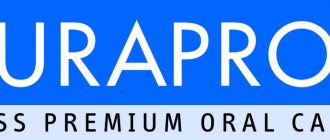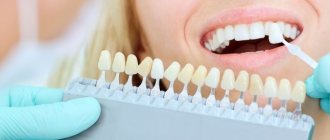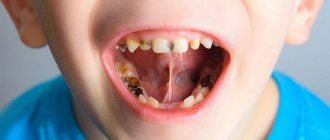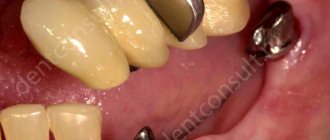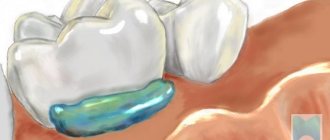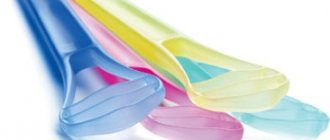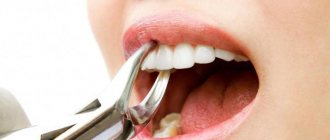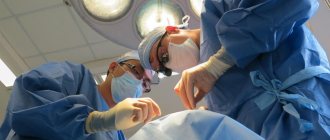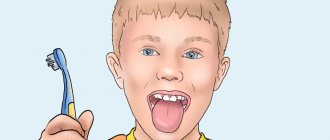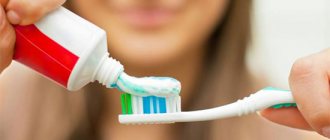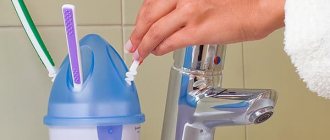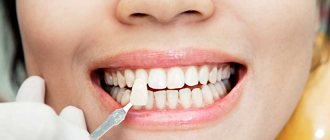When is the best time to start brushing children's teeth?
Correct, healthy habits are established in early childhood. This statement also applies to oral care. How competently parents teach their child to brush his teeth determines his future health and self-confidence. According to experienced doctors, it is worth starting to monitor oral hygiene even before the eruption of baby teeth. At first, experts advise wiping your gums with a piece of soft gauze soaked in warm boiled water. The procedure must be done twice a day.
When the baby's first teeth appear, parents are advised to get a special rubber brush. It is placed on the finger and gently cleans children's gums and teeth.
But you can start introducing a real toothbrush at about 1.5 years of age.
Choosing a brush according to age
Age from 1.5 to 3 years
To begin with, you should purchase a manual toothbrush with ultra-soft bristles that is appropriate for your age. It’s better to choose a model with a picture or pen in the shape of an animal or a favorite cartoon character so that the item evokes sympathy. Make sure that the child does not chew it, but rather brushes his teeth - otherwise it will be problematic to teach him proper hygiene.
Age from 3 to 7 years
When your child turns three years old, you can try offering him an electrical sample. The advantage is that such brushes have great opportunities for interaction, which means kids who did not like conventional devices may become interested in the new product. For children aged 3 to 6-7 years, dentists recommend choosing an electric brush with the softest bristles; you can use it in turn with a regular one (but also soft). Preschoolers must use an electrical device exclusively under the supervision of their parents.
Age from 8 to 13 years
When your child turns 8 years old, you can purchase a brush head of the same brand as his regular children's brush, but for sensitive teeth. It is slightly stiffer than directly on devices for very young children, but at the same time much softer than on adult models. Such a purchase can serve as a good option for a changing bite until the time comes to switch to a device with standard bristles.
Ages 13 years and older
Teenagers over 13 years of age can use electric brushes with medium-hard bristles. Of course, choosing an oral hygiene product is an individual matter, so you should buy it only after consulting with a dentist and assessing the condition of the enamel. If the doctor says that it is too early to switch to medium bristle hardness, then continue to purchase attachments for sensitive teeth.
What types of electric brushes are there?
Today, many varieties of electric brushes are produced: for adults and children, for people with certain dental diseases, with and without timers, round and oblong, etc. Depending on the type of movement of the bristles and the operating principle of the motor, these devices are divided into standard, sonic and ultrasonic.
Depending on the type of power supply, electric brushes are either rechargeable or battery-powered. There are models with additional functions, for example, ionic. They are equipped with a metal plate, which releases ions during brushing and enhances the cleansing effect.
Each type of toothbrush has its own advantages and disadvantages. Ultrasonic models are considered the most effective, but they are more expensive than other types of devices. However, the choice of a specific device is determined not only by price, but also by medical indications.
Types of electric brushes: which ones are suitable for children
The classification of dental care devices is common to everyone – both children and adults. However, not every gadget is suitable for a baby. Therefore, we will further consider those options that are approved for use in children.
Read on the topic: how to choose a good electric toothbrush for an adult - all types of popular devices in one detailed material.
- Classic model. The operation of a standard (or classic) device is based on the action of a miniature motor that drives the brush head. The bristles move back and forth or in a circle (and back) at a given speed, cleaning out food debris and plaque.
- Sound type. These models have a built-in generator, thanks to which the brush head emits high-frequency sound vibrations. They destroy deposits on enamel with greater efficiency and promote better formation of foam from toothpaste, which washes out even the smallest impurities well. Children can use such a brush, but under the supervision of adults and always under the supervision of a doctor - it is important to understand that sound waves do not cause harm.
- Ultrasonic type. The head of such a brush does not just move, the device produces ultrasonic waves that destroy dirt and germs. The frequency of ultrasound is about 40-50 thousand vibrations per minute. Therefore, such models are contraindicated for children, since the effect of ultrasound is detrimental to fragile enamel; it quickly destroys areas with weak mineralization.
Types of Electric Toothbrushes
The main types of electric brushes today include:
- reciprocating;
- combined;
- ultrasonic.
What they have in common is that they operate on electricity, which is where the name comes from, specifically from AA batteries or an AC adapter.
Of course, each of these types has variations; every year various new products appear, for example, reciprocating rotary ones with 3D technology, combined ones with different nozzles (CrossAction or Dual Clean) and the like, but the principle of their operation is usually similar in type.
Reciprocating rotary ones have a round head, which combines movements in a circle in different directions, with the help of which it loosens and sweeps away plaque from the tooth enamel.
In combination, in addition to the cup-shaped head, there are additional static cross bristles, providing greater access to the surface of the teeth.
The head of an ultrasonic brush resembles a regular manual one, and cleansing occurs due to the vibration of the bristles at high frequencies (a piezoceramic plate located under the bristles emits an ultrasonic wave, due to which its effect extends to hard-to-reach spaces in the teeth).
Ultrasonic toothbrush
The advent of the ultrasonic toothbrush created something of a boom in the world of electric models. Manufacturers claim that its use can replace the procedure for cleaning teeth with special equipment at the dentist, and even that now trips to the doctor can almost be canceled or, at least, the number of visits reduced.
This, of course, affects the popularity of this product among consumers, because going to the dentist rarely evokes positive emotions. However, dentists themselves are quite critical of such statements; moreover, they advise patients to beware, since there are a number of contraindications to the use of such electric toothbrushes.
In addition to the fact that such a brush mechanically removes plaque due to the vibration of the bristles, ultrasonic waves prevent microbes from attaching to the surface of the teeth. They also quite effectively remove soft pigment plaque.
In general, consumers of such brushes are satisfied and the reviews are mostly positive.
It polishes and whitens teeth perfectly, reaches well in hard-to-reach places and is generally inexpensive. The disadvantages are that they run out of charge quickly, and the brush heads need to be changed as often as a regular toothbrush, and they are not cheap.
Veronica
Indeed, such brushes cope with light neoplasms on the teeth quite easily, but even small hard deposits on the teeth will be much more difficult for them to cope with. If you have extensive hard deposits, it will not help you in any way; here you need to undergo dental procedures from a doctor. Therefore, it is still impossible to say that electric toothbrushes replace a visit to the dentist.
What to look for when choosing
The stiffness of the bristles
As already mentioned, children's teeth are more vulnerable to decay than those of adults. Milky enamel is more fragile because contains less calcium and phosphorus. And the natural process of remineralization often fails due to the large number of harmful foods in the diet, this must be taken into account. That's why electric brushes for babies are distinguished by soft and fine bristles, so that cleaning is as gentle as possible.
Good to know! If you already have an “adult” brush at home with a gentle cleaning mode, when the device works without pulsating, it will be quite suitable for a child over 7 years old. Of course, you will need to buy a separate attachment that is suitable for the baby in terms of softness and size.
Equipment - nozzles, operating modes and sensors
Electronic hygiene products can be programmed to operate in multiple modes and come with multiple attachments for different purposes. For example, the kit may include a head for massaging the gums, cleansing the tongue and cheeks. The most useful functions for such a device are a pressure sensor and a timer that measures the cherished 2 minutes of cleaning. They will help control the procedure time and prevent damage to sensitive enamel.
“Since my son started brushing with an electric brush, his teeth have become much whiter, and the plaque on his gums no longer accumulates in the same amount. And he himself became much more interested in using such a fashionable gadget. And the built-in timer is just a godsend for kids. It works every 30 seconds, changing the vibration frequency. So it becomes clear that it’s time to clean another area.”
Miura, review from irecommend.ru
Please note age restrictions
When buying an electric brush, you need to make sure that its characteristics are optimal for the baby’s age. The packaging usually states what age category the device is intended for: from 3, 5, 6 or 7 years old.
Electric brush power method
Which gadget to buy—battery-powered or rechargeable—is another important question. The first ones operate on one power source for up to three months, then the battery will have to be replaced. The device with the battery is charged from the network. Energy lasts for an average week.
Availability of a mobile application
Children over 5 years old will be delighted with the brush with the option of synchronizing with a smartphone. A special application is installed on the phone, through which the little researcher can track his progress and receive valuable advice on improving his skills.
Nuances of choice
- Thorough cleaning of the tooth surface is possible with a sufficient length of the working part - 2-2.5 cm. This size is designed to capture several teeth at the same time.
- The head of the brush should be rounded so as not to injure the mucous membrane. The unevenness of the outer part provides additional hygiene.
- The movable junction between the head and the handle puts moderate pressure on the crowns and gums.
- The handle with rubber inserts makes the brush more comfortable to use and prevents it from slipping in your hands.
Need to consider:
- Ultrasonic and ionic models greatly facilitate care, but are less accessible due to their high cost.
- Electric ones effectively cope with the function of cleaning teeth. Do not use for gum diseases or unhealed sutures.
- Manual ones are cheaper than others, but are effective only if the correct movements are performed.
Correct holding and application
Choose a device so that its handle fits comfortably in a child’s palm and does not slip. Discuss with your child what the brush “can do” and how it works. Then learn how to hold it. Watch the training video together. Videos with cartoon characters, funny characters, or kids the same age as the main characters will come in very handy. Show how to move the brush correctly in the mouth, explain that you need to spend time on each tooth - this is important.
On a note! You can learn more about how to properly brush your teeth with an electric brush from another thematic material.
Children aged 5 years and older can easily cope with the task themselves, but mothers and fathers should still keep an eye on the baby. It will be great if joint oral hygiene becomes a family tradition.
How to teach your child self-hygiene
It is best that adults, by personal example, introduce their son or daughter to self-care from early childhood and show that it is pleasant and useful. Oral hygiene should be carried out in the form of role-playing games, using your favorite toys. As a rule, children willingly copy the behavior of their parents if they want to show off their size and take part in something interesting.
It is important to know! Do not force or intimidate your child into brushing their teeth. Do not try to get him to perform all manipulations regularly and within a strictly allotted time from the first days. This approach will discourage you from picking up a brush and toothpaste for a long time, and the procedure itself will be associated only with negativity.
Proper cleaning
Proper cleaning plays a major role in caring for dental implants. The procedure for cleaning the structure is somewhat similar to standard teeth cleaning, but requires a more thorough approach.
How to clean with a toothbrush?
To clean implants, any toothpaste and any type of toothbrush can be used: standard, special, electric. The main thing is that it has soft bristles .
Cleaning is carried out at least twice a day: morning and evening. When cleaning the protruding element of the implant, special attention should be paid to the part adjacent to the gum. The surface facing the interdental space should be treated especially carefully.
We will tell you what a metal-plastic crown is in a separate review.
In this article we will talk about how to care for removable dentures.
At the link https://www.vash-dentist.ru/implantatsiya/metodiki/miniimplantyi.html you will find reviews about the ease of using removable dentures on mini-implants.
Cleansing procedure:
- using an up and down motion, the outside of the implant is cleaned;
- then plaque is removed from the lingual surface and interdental space using sweeping movements;
- finally, clean the upper part of the structure using circular movements.
It is recommended to supplement this procedure with massage of the gums with a toothbrush without toothpaste.
Do you need dental floss?
Floss is a mandatory and indispensable tool for cleaning the implant. Dental floss helps clean gaps between and around structural elements.
To do this, the thread is passed from side to side along the implant in a reciprocating motion. To obtain a polishing effect, you can pre-apply toothpaste .
In addition, the paste has a protective and softening effect on adjacent tissues.
The technique for daily care of implants is shown in the video:
Rinse after meals
If possible, cleaning should be done every time after eating. But if there are no necessary conditions for this, then this procedure should be replaced by rinsing. As a last resort, ordinary water or decoctions of medicinal plants are suitable for this.
The best option is rinses with antibacterial or anti-inflammatory effects .
Anti-inflammatory balms are preferable, since antibacterial complexes, with frequent use, destroy not only pathogenic microbes, but also beneficial ones, thereby changing the flora of the oral cavity and reducing protective functions.
It is best to have your dentist select the rinse products. Do not forget that rinsing is only an auxiliary means of cleaning the implant.
Use of irrigators
To more effectively clean the structure, it is recommended to use a special device - an irrigator. The device uses a water jet to help get rid of plaque in places where even bristles cannot penetrate .
In addition, according to reviews, the device effectively massages the gum tissue, improving blood circulation and promoting its active restoration. The principle of operation of the irrigator is to supply a stream of water, saturated with oxygen by the built-in air filter.
Water can be supplied through different types of nozzles that differ in flow intensity. The average procedure time is 3 minutes.
Contraindications for using the device
Dentists name several main factors when the use of an electric toothbrush by a child is contraindicated:
- the presence of wedge-shaped defects: we are talking about depressions that appear at the base of the tooth and can increase over time, exposing the neck. Intense mechanical impact contributes to the development of this pathology,
- bottle caries: it occurs in babies who are often fed milk, formula, or foods containing a lot of sugar (including juices, cookies) before bedtime. Leftover food is an ideal breeding ground for microbes that destroy enamel. As a result, first whitish, then brownish spots appear on the enamel layer. These areas should not be subjected to strong pressure, otherwise the situation will worsen,
- high rate of enamel abrasion: occurs quite often in children. The cause may be an incorrect bite or a not well-studied disease such as bruxism (grinding teeth during sleep), as well as heredity and fragility of enamel caused by various diseases,
- the presence of areas of enamel with low mineralization: white spots - the first harbingers of caries. If a child experiences such phenomena, an electric brush is contraindicated for him. First you need to undergo a remineralization course, otherwise the device will do more harm than good,
- Gum disease: Another reason to put off using a powered device. Even soft stubble can aggravate inflammation, so the first step is to get rid of the troublesome ailments.
The best electric brushes for children
Below are models that are recommended by dentists and parents according to numerous reviews.
Oral-B Stages Power – from 3 years
A worthy representative of the family of classic brushes for ages from 3 years. Available in a set with a stand and a single round nozzle (but replaceable). Cleans in standard mode and makes up to 7600 movements per minute. It takes energy from the battery, which provides about 30 minutes of continuous operation. There is a timer and bristle wear indicator. The device has an original design, for example, in the style of the cult film “Star Wars”, “Cars” or with princesses. This gadget will appeal to both boys and girls.
The downside is that there is no pressure sensor and the attachments for changing are quite expensive (about 300-400 rubles apiece). The best price is 1100 rubles. Average – 1500 rubles.
Philips Sonicare For Kids – from 3 years
Sound model for children from 7 years old (but can also be used from 3 years old, you just need to choose an ultra-soft nozzle). The set includes a storage stand and two elongated attachments designed for different ages - from three years and from seven years. Each operates in two modes – standard and delicate. Operates1 at a maximum speed of up to 31 thousand pulsations per minute.
The device is powered by a built-in battery. It has a maximum range of functions: the option of gradually getting used to the device, a charge indicator, a timer and a pressure sensor on the tooth. The device communicates with an application on a smartphone via Bluetooth. Thanks to this, the child gets the opportunity to learn how to brush their teeth in a playful way, following the advice of a virtual character. The application has a motivation system: the child receives encouragement for all successes. Thus, the device turns the procedure into an exciting quest. The device comes complete with eight colored stickers for the handle, which depict funny animals. Exactly what was described above - positive emotions create the right mood.
The downside is that the cost is quite high. The best price is 5190 rubles.
CS Medica SonicPulsar Junior – from 5 years
An affordable and high-quality sonic brush for children over 5 years old. The body is complemented by a rubberized handle for the convenience of the small owner. Comes in a set with two elongated nozzles, equipped with bright LED lighting. Together with the beautiful color of the hand, it creates a mood and attracts the child’s attention. It operates in standard mode and produces up to 16 thousand pulsations per minute. Operates on a battery, the charge of which lasts for up to five months. There is a timer to control the cleaning time. After two minutes of operation, the device turns off automatically.
The downside is that there is no pressure sensor or bristle wear indicator. The best price is 800 rubles.
Oral-B Junior – from 6 years of age
A classic, high-quality electric brush for a 6-year-old child. Comes with a storage stand and a single round shaped head. Cleans in standard mode. Powered by a battery and charged from the mains. The power source energy lasts up to 10 days. There are charge level and bristle wear indicators, as well as a timer.
The downside is that there is no pressure sensor. The best price is 2000 rubles.
Rating of sonic toothbrushes
The peculiarity of the sound model is acoustic vibrations. Vibration affects all structures in a complex manner. The review was created based on the opinions of dentists and user reviews. When compiling the rating, the following parameters were taken into account:
- Type. Affects the intensity of cleansing;
- Number of modes. Certain functions provide high-quality teeth cleaning, tongue cleaning and massage;
- Speed of work. A large number of revolutions can cause injury;
- Head configuration. Round elements allow you to repeat the shape of the tooth, as well as provide cleansing in hard-to-reach areas;
- Bristle size and material. Synthetic pile has a long service life.
Important selection criteria are the attachments and the type of power supply. Before purchasing, you should not only read the review, but also consult a dentist. You need to remember about contraindications. Due to vibrations, they cannot be used by pregnant women or people with a pacemaker.
The best dental floss
